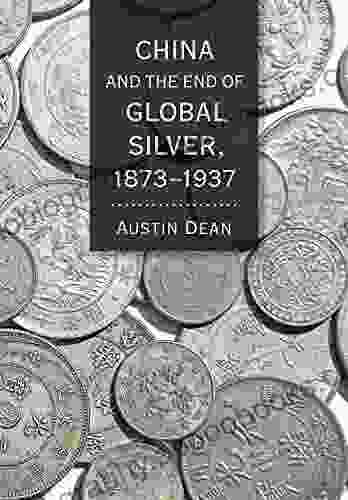China and the End of Global Silver, 1873-1937: Unraveling the Dynamics of Monetary Regimes

In the annals of economic history, the period from 1873 to 1937 stands as a pivotal era, marked by profound shifts in global monetary systems. At the heart of these transformations was the changing role of silver, a precious metal that had long served as a primary medium of exchange and store of value.
5 out of 5
| Language | : | English |
| File size | : | 28951 KB |
| Text-to-Speech | : | Enabled |
| Screen Reader | : | Supported |
| Enhanced typesetting | : | Enabled |
| Word Wise | : | Enabled |
| Print length | : | 264 pages |
In his groundbreaking book, "China and the End of Global Silver, 1873-1937," renowned economic historian Toniolo Gianni delves into the intricate relationship between China and the global silver market, shedding light on its profound impact on monetary regimes worldwide.
The Rise and Fall of Silver
During the 19th century, silver played a central role in global trade and finance. Its dominance was largely attributed to the vast silver reserves in Mexico and the Americas, which fueled a steady supply of the metal to international markets. However, the discovery of new silver deposits in the United States and Australia in the 1870s disrupted this established Free Download.
The sudden influx of silver led to a sharp decline in its value relative to gold. This phenomenon, known as the "Silver Crisis" of 1873, had far-reaching consequences for countries that maintained silver-based currencies.
China's Pivotal Role
China, with its immense population and long-standing dependence on silver, played a pivotal role in the global silver market. The country's vast demand for silver, primarily driven by its use in jewelry and coinage, absorbed a significant portion of the world's silver supply.
As the value of silver plummeted, China faced increasing pressure to abandon its silver-based currency. However, the government resisted this change, fearing the economic and social upheaval it would entail.
Monetary Regimes in Flux
The changing value of silver and China's pivotal role in the global silver market had a profound impact on monetary regimes around the world. Countries that had maintained silver-based currencies, such as India, Mexico, and China, faced the difficult decision of whether to devalue their currencies or adopt a gold standard.
The book meticulously examines the complex interplay between monetary policy, international trade, and geopolitical factors in shaping the decisions made by governments during this period.
The Collapse of the Silver Standard
The global silver market reached a tipping point in the early 20th century. In 1931, the United States abandoned the gold standard, a move that sent shockwaves through the international monetary system.
Other countries, including China, were forced to follow suit, leading to the collapse of the global silver standard. This event marked a fundamental shift in the world's monetary landscape, paving the way for the dominance of gold and, later, fiat currencies.
A Comprehensive Analysis
"China and the End of Global Silver, 1873-1937" is a comprehensive and meticulously researched analysis of this pivotal era in economic history. Drawing on a wealth of archival sources, Gianni Toniolo unravels the intricate dynamics of the global silver market and its profound impact on monetary regimes worldwide.
The book is essential reading for scholars, students, and anyone interested in the history of money, international trade, and economic development. Its insights offer valuable lessons for understanding the complexities of global financial systems and the challenges faced by policymakers in an ever-changing economic landscape.
5 out of 5
| Language | : | English |
| File size | : | 28951 KB |
| Text-to-Speech | : | Enabled |
| Screen Reader | : | Supported |
| Enhanced typesetting | : | Enabled |
| Word Wise | : | Enabled |
| Print length | : | 264 pages |
Do you want to contribute by writing guest posts on this blog?
Please contact us and send us a resume of previous articles that you have written.
 Book
Book Novel
Novel Page
Page Chapter
Chapter Text
Text Story
Story Genre
Genre Reader
Reader Library
Library Paperback
Paperback E-book
E-book Magazine
Magazine Newspaper
Newspaper Paragraph
Paragraph Sentence
Sentence Bookmark
Bookmark Shelf
Shelf Glossary
Glossary Bibliography
Bibliography Foreword
Foreword Preface
Preface Synopsis
Synopsis Annotation
Annotation Footnote
Footnote Manuscript
Manuscript Scroll
Scroll Codex
Codex Tome
Tome Bestseller
Bestseller Classics
Classics Library card
Library card Narrative
Narrative Biography
Biography Autobiography
Autobiography Memoir
Memoir Reference
Reference Encyclopedia
Encyclopedia Al Braden
Al Braden Mark R Warren
Mark R Warren Michael P Johnson
Michael P Johnson Elyn Aviva
Elyn Aviva Dale Russakoff
Dale Russakoff Timothy J Smith
Timothy J Smith Ruth Lane
Ruth Lane Karsten Potts
Karsten Potts Rebecca Cantrell
Rebecca Cantrell Octavio Paz
Octavio Paz Carol Shinn
Carol Shinn David Vincent
David Vincent Sara A Mueller
Sara A Mueller James Goldberg
James Goldberg Eric Raillard
Eric Raillard Alastair Williams
Alastair Williams Susan Kennedy
Susan Kennedy David Richo
David Richo Alecky Blythe
Alecky Blythe George Washington
George Washington
Light bulbAdvertise smarter! Our strategic ad space ensures maximum exposure. Reserve your spot today!

 Stuart BlairDiscover the Intriguing World of Mayenburg's Three-Play Masterpiece: A Modern...
Stuart BlairDiscover the Intriguing World of Mayenburg's Three-Play Masterpiece: A Modern... Kyle PowellFollow ·18.7k
Kyle PowellFollow ·18.7k Natsume SōsekiFollow ·7.6k
Natsume SōsekiFollow ·7.6k Cristian CoxFollow ·19.7k
Cristian CoxFollow ·19.7k Joel MitchellFollow ·15.1k
Joel MitchellFollow ·15.1k John KeatsFollow ·17.8k
John KeatsFollow ·17.8k Easton PowellFollow ·6.3k
Easton PowellFollow ·6.3k Carson BlairFollow ·6k
Carson BlairFollow ·6k John Dos PassosFollow ·13.1k
John Dos PassosFollow ·13.1k

 W. Somerset Maugham
W. Somerset MaughamBach Dialogue With Modernity: A Journey Through Time and...
Prelude: Bach's Timeless...

 Ted Simmons
Ted SimmonsAsher Heroes At Heart Maryann Jordan: The Essential Guide...
Are you ready to...

 Paulo Coelho
Paulo CoelhoVienna Spies: Uncover the Hidden World of Espionage in...
Vienna has long...

 Herman Melville
Herman MelvilleThe Complete Guide to Orchestral Cymbal Playing:...
Step into the vibrant...

 Rubén Darío
Rubén DaríoEscape into a Holiday Haven with California Christmas...
Embark on a heartwarming and festive journey...
5 out of 5
| Language | : | English |
| File size | : | 28951 KB |
| Text-to-Speech | : | Enabled |
| Screen Reader | : | Supported |
| Enhanced typesetting | : | Enabled |
| Word Wise | : | Enabled |
| Print length | : | 264 pages |












